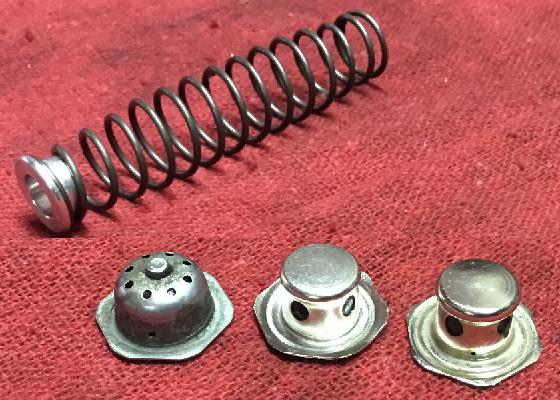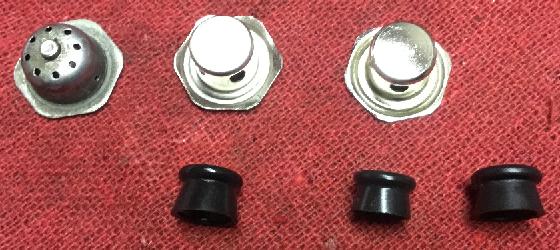The MGA With An Attitude
Dragging Brakes, RESIDUAL PRESSURE - BT-101R
This article is written in response to a few continuing questions about function of residual pressure in the hydraulic braking system. The short of it is, in most cases residual pressure is not actually required, but some restriction to return flow is needed. The devil is in the detail.
Residual pressure in the brake system is not a bad thing. It is intended to have a low level of residual pressure. Too much residual pressure is a bad thing. Original specification for residual pressure is 8-psi, which works well for both drum and disc brakes. When the "faulty" after market master cylinder has 12-psi residual pressure it makes the disc brakes drag (but still may not affect drum brakes).
Next consideration is that the residual pressure is not expected to be retained indefinitely, and the braking system will work perfectly well with zero residual pressure. Temperature changes make fluid expand and contract. When brakes are hot, and then may be driven for some time on open road without use and allowed to cool, the residual pressure will go away as fluid contracts. When slave cylinder seals are in good condition, air will NOT be drawn into the system past the seals. As fluid contracts, more fluid will enter the lines from the master cylinder reservoir. Residual pressure is not required to prevent air intrusion.
Clutch slave cylinders and (many) drum brake slave cylinders have a small compression spring to gently press the cup seal forward. There is also (often) a plastic "expander" which may or may not actually expand the sealing lip of the cup seal, but serves to distribute pressure of the spring across most of the area of the seal cup, and it keeps the cup seal squarely seated against the face of the piston. It is this light force spring that prevents fall back of the seal cup during prolonged periods of non-use and severe vibration. This is particularly important for the clutch slave cylinder where the piston does not go back to rest against a mechanical stop. Some slave cylinders use a ring seal that does not require the light compression spring for seating of the seal cup (but the clutch slave may still need the spring to prevent fall back).
Drum brake shoe return springs have high enough tension force to return the slave pistons with more than 8-psi return pressure (also more than 12-psi apparently), so the slave cylinders will always return completely to mechanical rest position. This is why the brake shoes need to be re-adjusted as they wear, so they do not develop excess clearance (which would make excessively long pedal pre-travel). At no time will residual pressure be sufficient to hold the brake shoes forward in the extended position. If it did the shoes would constantly drag, over heat and wear out quickly. There is never any mechanism to hold the shoes gently against the drums. The shoes must fall back, and they need to be adjusted occasionally to prevent excessive fall back with progressive wear. Some drum brakes have automatic adjusters.
Brake pads with disc brakes are NOT returned by run-out and kick-back of the rotor. Rotor run-out must be limited to a few thousandths of an inch at most (to prevent severe vibration). Wheel bearing running clearance may allow the rotor to wobble a few thou more. But this wobble is not required to return the pads. Some cars run a preload on tapered roller bearings, so the rotor (a straight rotor) will not wobble at all.
Of course the pads do need to be retracted slightly to avoid drag on the rotors, and the pads cannot be allowed to retract too far (which would cause excessive pre-travel of the pedal). The return function in disc brake calipers is provided by friction and flexing or the rubber piston seal. As the piston is pushed forward it is forced through the seal. In the process, friction causes the seal to deform slightly. When hydraulic pressure is released the rubber seal relaxes, which in turn pulls the piston back slightly. The brake pads are then free to float in the small space allowed. Air film then is drawn in between the rotor and pad by motion of the rotor, which pushes the pad gently back against the piston, which in turn provides the small air gap to prevent the pad from dragging on the rotor.
In some early disc brake caliper designs there was a special friction and minimal clearance mechanism built into the caliper piston to prevent excessive retraction (fall back) of the piston during extended periods of running without using the brakes. The Dunlop (4-wheel) disc brakes used on MG MGA Twin Cam chassis had these parts. Also Lockheed front disc brakes used on MGA 1600 cars (1959-1962) had these parts. MGB (in 1962) did not have the anti-fall-back part in the calipers, as by that time it was realized the at it wasn't needed.
The same friction in the seal of the caliper piston that deforms the seal to cause piston retraction also prevents the piston from having excessive fall back. The soft and very flexible dust seal boot on the outside has nothing to do with either piston withdraw or excessive fall back.
Residual pressure in the master cylinder is a side effect of function of the "non-return" valve (or "inlet and outlet check valve") which allows you to pump up the brakes (in case of excessive pedal travel). The trick is a requirement to restrict the return flow slightly, at least long enough to make the next pedal stroke, to facilitate the pump up function. The way it works in most brake master cylinders is, the spring that returns the master piston also applies some force on the foot valve in bottom of the bore. There is a light force check valve that allows fluid to flow forward freely. Return flow is restricted by the spring loaded pressure foot, which is where the residual pressure happens.

Left to right, a 1/32" drilled TRW valve, a new AP valve, and the original one from the Lockheed master cylinder. Notice the tiny hole (smaller than 1/32") at base of the original valve foot.

Long skirt check seal cup from new AP valve, short skirt cup from original Lockheed valve, long skirt cup from Moss Motors rebuild kit (in 2019).
The problem with the faulty master cylinder is too much force on the piston return springs, which causes about 12-psi residual pressure rather than the intended 8-psi. This excessive residual pressure is what causes the disc brakes to drag. But as I stated earlier, the residual pressure is not actually required (at least not long term). For the master cylinder having too much residual pressure, we simply drill a tiny hole in the pressure foot. This allows restricted slow return of the fluid, which facilitates the pump up function of the brakes. It does bleed off all residual pressure within a few seconds of release of the brakes.
But this does not otherwise affect brake function, because residual pressure is not required. In fact residual pressure is most often not present at all on most systems when you drive for prolonged periods without using the brakes. As fluid cools and contracts it pulls more fluid into the lines from the master cylinder reservoir. When this is happening there is no residual pressure in the lines. It will then have a very slight vacuum level in the lines to pull fluid from the master cylinder reservoir.
For certain competition applications it may be desirable to have virtually zero pre-travel of the brake pedal. Also for competition a little bit of drag and heating and wear on brake pads may not be much concern. To do this requires keeping the friction linings in constant contact with drums and rotors. For these cases it may be appropriate to install a residual pressure valve in the line between master cylinder and slave cylinders. That may be something slightly higher than 12-psi for drum brakes, and maybe as much as 10-psi for disc brakes. The "normal" 8-psi will not do it for either drum or disc brakes.
When seals in calipers of disc brakes get old the rubber gets hard and will not have the required resiliency to flex and retract the pistons. Then the pads can drag and wear and over heat even with zero residual pressure in the lines. That's when it is time to rebuild the calipers to install new rubber seals.
|